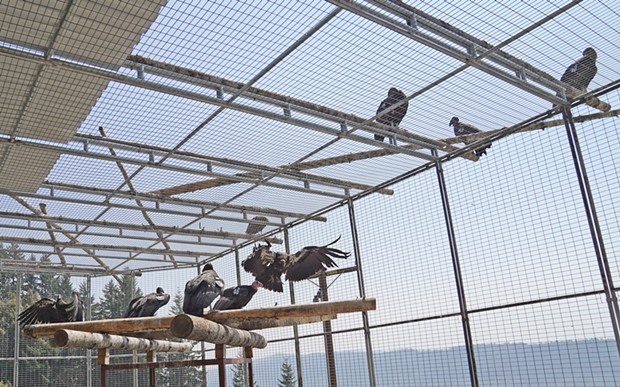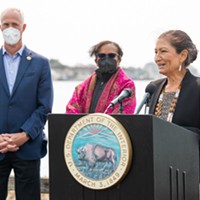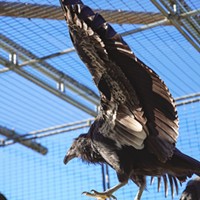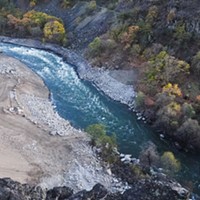Tuesday, November 22, 2022
Lead Ammo in Poached Elks Could Have Killed Condors
Posted By Kimberly Wear @kimberly_wear on Tue, Nov 22, 2022 at 4:24 PM
Two elks were killed by poachers using lead ammo in an area frequented by the California condors now flying free in the region, putting the endangered birds’ lives in danger.
According to a release from the Northern California Condor Restoration Program — a partnership between the Yurok Tribe and Redwood National and State Parks — one of the carcasses discovered Nov. 12 “contained enough lead to kill several condors.”
“This is about as close as you can get to a worst-case scenario. If the carcasses weren’t quickly reported, and our free-flying condors accessed them, it is very likely that one or more of the condors would have consumed a life-threatening quantity of lead,” said NCCRP Manager and Yurok Wildlife Department Manager Chris West, who has more than two decades of condor management experience. “The risk this incident presented to the condors cannot be understated, since at least four of our recently released condors were less than a 10-minute flight from the poaching event at the time that it occurred.”
The release states the poaching case is being investigated by officers with Redwood National and State Parks and the California Department of Fish and Wildlife. Anyone with information is urged to come forward by calling NPS Ranger Attendorn at (707) 465-7789 or Game Warden Castillo at (707) 673-3678. Anonymous reports can also be made to the CDFW CalTip at (888) 334-CalTIP (888 334-2258) or by calling the park’s crime tip line at (707) 765-7353.
“Based on the circumstances, we’re lucky we didn’t have to transport condors for treatment or lose a bird to lead poisoning,” said Yurok Wildlife Department Director Tiana Williams-Claussen, who spent most of her adult life working to fulfill a council of Yurok elders’ wish to bring back the bird they hold sacred and know as prey-go-neesh to its historic territory. “Lead is by far the single biggest threat to condors in the wild.”
Known as nature’s clean-up crew, condors play an important role in the ecosystem as apex scavengers that use their powerful beaks to pierce the tough skins of dead animals ranging from elk to sea lions and even the occasional whale, clearing the large carcasses from the landscape and helping to prevent the spread of disease.
This makes the massive birds with a nearly 9-foot wingspan highly susceptible to lead poisoning from ammunition. In this case, the NCCRP states “several lead fragments, including the bulk of the lead ammunition round, were found in the neck of one of the cow elk and within a fist-sized chunk of meat presumably dropped by the poachers at the site.”
Since being reintroduced into the wild, about half of the condor deaths have been attributed to the birds eating lead fragments in animal carcasses.
“In general, when a condor consumes lead fragments, the bird will experience a series of worsening symptoms that often unfold over the course of days and weeks and lead to an excruciating death,” the release states.
The area of the kill, according to NCCRP, was scoured of any meat containing lead, including around 40 pounds left on each of the illegally poached elk.
“We are so fortunate that we did not lose one or more members of the new condor population,” Redwood National and State Parks Superintendent Steven Mietz states in the release. “We are doing everything possible to find the people who illegally killed the elk and put the new condor population at risk. If you have any information that might help us hold those responsible for this illegal act accountable, please contact the park or the California Department of Fish and Wildlife.”
Before March, the last sighting of a California condor in the North Coast region occurred in 1892. Local populations had been decimated by settlers who poisoned and shot the condors, as well as destroyed habitat and depleted their food supply by over hunting the game and marine mammals on which they depended.
Declared endangered in 1967, there were fewer than 100 surviving in the wild. Two two decades later, only 22 remained in a small pocket of mountainous area in Southern California. In 1987, the last of the wild condors were placed into captive breeding programs in a race against time to save the largest bird in North America from extinction.
For decades, the Yurok Tribe has worked to bring prey-go-neesh back to the North Coast in one of many efforts to bring balance back to their lands.
As of 2019, some 500 are now flying free in the wild, with the eight released locally by the NCCRP — the first taking flight in May and the most recent last week — adding to those numbers.
The local wild flock now includes: Ney-gem' 'Ne-chween-kah (She carries our prayers, A0), Hlow Hoo-let (Finally, I/we fly, A1), Nes-kwe-chokw' (He returns/arrives, A2) and Poy'-we-son (The one who goes ahead, “leader,” A3) as well as Cher-perhl So-nee-ne-pek' (I feel strong, A4); and Neee'n (Watcher, A5) Me-new-kwek (I’m bashful or I’m shy, A6) and He-we-chek' (I am healthy or I get well, A7).
“Every condor is critical and sacred. Older condors teach younger birds how to make it in the wild. When a condor dies prematurely from lead poisoning, all of the knowledge it amassed throughout its life, such as where to find forage or safely roost for the night, is lost and won’t be transmitted to the next generation,” Williams-Claussen said in the release. “This transmission of knowledge is essential to the health of our condor population. In order to conserve the species, it’s critical to transition to non-lead ammunition, which is high performing and viable as a harvest tool.”
According to a release from the Northern California Condor Restoration Program — a partnership between the Yurok Tribe and Redwood National and State Parks — one of the carcasses discovered Nov. 12 “contained enough lead to kill several condors.”
“This is about as close as you can get to a worst-case scenario. If the carcasses weren’t quickly reported, and our free-flying condors accessed them, it is very likely that one or more of the condors would have consumed a life-threatening quantity of lead,” said NCCRP Manager and Yurok Wildlife Department Manager Chris West, who has more than two decades of condor management experience. “The risk this incident presented to the condors cannot be understated, since at least four of our recently released condors were less than a 10-minute flight from the poaching event at the time that it occurred.”
The release states the poaching case is being investigated by officers with Redwood National and State Parks and the California Department of Fish and Wildlife. Anyone with information is urged to come forward by calling NPS Ranger Attendorn at (707) 465-7789 or Game Warden Castillo at (707) 673-3678. Anonymous reports can also be made to the CDFW CalTip at (888) 334-CalTIP (888 334-2258) or by calling the park’s crime tip line at (707) 765-7353.
“Based on the circumstances, we’re lucky we didn’t have to transport condors for treatment or lose a bird to lead poisoning,” said Yurok Wildlife Department Director Tiana Williams-Claussen, who spent most of her adult life working to fulfill a council of Yurok elders’ wish to bring back the bird they hold sacred and know as prey-go-neesh to its historic territory. “Lead is by far the single biggest threat to condors in the wild.”
Known as nature’s clean-up crew, condors play an important role in the ecosystem as apex scavengers that use their powerful beaks to pierce the tough skins of dead animals ranging from elk to sea lions and even the occasional whale, clearing the large carcasses from the landscape and helping to prevent the spread of disease.
This makes the massive birds with a nearly 9-foot wingspan highly susceptible to lead poisoning from ammunition. In this case, the NCCRP states “several lead fragments, including the bulk of the lead ammunition round, were found in the neck of one of the cow elk and within a fist-sized chunk of meat presumably dropped by the poachers at the site.”
Since being reintroduced into the wild, about half of the condor deaths have been attributed to the birds eating lead fragments in animal carcasses.
“In general, when a condor consumes lead fragments, the bird will experience a series of worsening symptoms that often unfold over the course of days and weeks and lead to an excruciating death,” the release states.
The area of the kill, according to NCCRP, was scoured of any meat containing lead, including around 40 pounds left on each of the illegally poached elk.
“We are so fortunate that we did not lose one or more members of the new condor population,” Redwood National and State Parks Superintendent Steven Mietz states in the release. “We are doing everything possible to find the people who illegally killed the elk and put the new condor population at risk. If you have any information that might help us hold those responsible for this illegal act accountable, please contact the park or the California Department of Fish and Wildlife.”
Before March, the last sighting of a California condor in the North Coast region occurred in 1892. Local populations had been decimated by settlers who poisoned and shot the condors, as well as destroyed habitat and depleted their food supply by over hunting the game and marine mammals on which they depended.
Declared endangered in 1967, there were fewer than 100 surviving in the wild. Two two decades later, only 22 remained in a small pocket of mountainous area in Southern California. In 1987, the last of the wild condors were placed into captive breeding programs in a race against time to save the largest bird in North America from extinction.
For decades, the Yurok Tribe has worked to bring prey-go-neesh back to the North Coast in one of many efforts to bring balance back to their lands.
As of 2019, some 500 are now flying free in the wild, with the eight released locally by the NCCRP — the first taking flight in May and the most recent last week — adding to those numbers.
The local wild flock now includes: Ney-gem' 'Ne-chween-kah (She carries our prayers, A0), Hlow Hoo-let (Finally, I/we fly, A1), Nes-kwe-chokw' (He returns/arrives, A2) and Poy'-we-son (The one who goes ahead, “leader,” A3) as well as Cher-perhl So-nee-ne-pek' (I feel strong, A4); and Neee'n (Watcher, A5) Me-new-kwek (I’m bashful or I’m shy, A6) and He-we-chek' (I am healthy or I get well, A7).
“Every condor is critical and sacred. Older condors teach younger birds how to make it in the wild. When a condor dies prematurely from lead poisoning, all of the knowledge it amassed throughout its life, such as where to find forage or safely roost for the night, is lost and won’t be transmitted to the next generation,” Williams-Claussen said in the release. “This transmission of knowledge is essential to the health of our condor population. In order to conserve the species, it’s critical to transition to non-lead ammunition, which is high performing and viable as a harvest tool.”
For more information on the impacts of use of lead, and transitioning to non-lead ammunition, please visit huntingwithnonlead.org.
Read the full NCCRP release below:
Poachers kill two elk, leave lead-tainted carcass within range of recently released condors – NCCRP quickly removes carcass, prevents lead exposure
On Saturday, November 12, the Northern California Condor Restoration Program performed x-rays on two elk that were illegally killed in an area frequented by the recently released condors. One of the carcasses contained enough lead to kill several condors.
“This is about as close as you can get to a worst-case scenario. If the carcasses weren’t quickly reported, and our free-flying condors accessed them, it is very likely that one or more of the condors would have consumed a life-threatening quantity of lead,” said NCCRP Manager and Yurok Wildlife Department Manager Chris West, who has more than two decades of condor management experience. “The risk this incident presented to the condors cannot be understated, since at least four of our recently released condors were less than a 10-minute flight from the poaching event at the time that it occurred.”
“Based on the circumstances, we’re lucky we didn’t have to transport condors for treatment or lose a bird to lead poisoning,” said Yurok Wildlife Department Director Tiana Williams-Claussen. “Lead is by far the single biggest threat to condors in the wild.”
“We are so fortunate that we did not lose one or more members of the new condor population,” added Redwood National and State Parks Superintendent Steven Mietz. “We are doing everything possible to find the people who illegally killed the elk and put the new condor population at risk. If you have any information that might help us hold those responsible for this illegal act accountable, please contact the park or the California Department of Fish and Wildlife.”
Officers with Redwood National and State Parks and the California Department of Fish and Wildlife are investigating the incident and ask for the public’s assistance in this case. Investigating officers are urging anyone with any information to call either NPS Ranger Attendorn at 707 465 7789 or Game Warden Castillo at 707-673-3678. To anonymously make a report, please call CDFW’s CalTip at 1-888-334-CalTIP (888 334-2258) or call the park’s anonymous crime tip line at 707 765 7353.
Several lead fragments, including the bulk of the lead ammunition round, were found in the neck of one of the cow elk and within a fist-sized chunk of meat presumably dropped by the poachers at the site. All meat containing lead was removed from the site. Additionally, approximately 40 pounds of consumable meat were left on each animal.
Lead is the leading cause of condor mortality. Since the critically endangered avian scavengers were first reintroduced in 1992, more than half of all condor fatalities have been linked to the ingestion of lead fragments from consumed animals shot with lead ammunition.
When an animal is shot with a lead bullet, much of projectile breaks apart upon impact and continues to fragment as it travels through muscle, bone, and organ tissue. Hundreds of lead particles, ranging from the size of a fingernail to a speck of dust, may travel more than one foot from the wound channel. For this reason, small metal fragments frequently spread broadly through meat and viscera of lead-shot animals. In Southern California, many healthy condors have expired after eating one lead-tainted meal.
Condors only consume decomposing animal tissue or carrion. The large vultures normally ingest small bones in the carrion, along with dirt, pine needles and other natural yet undigestible debris. Similar to owls, condors have a way to caste or “cough up” most of the undigestible bits. But often this does not happen with lead. When a condor consumes carrion containing lead fragments, an early side effect of lead toxicosis, or lead poisoning, is paralysis of the gastrointestinal tract.
As a result, the heavy metal stays in the tract where strong acids continue to release highly toxic lead particles into the condor’s bloodstream. With each meal, the toxic metal is exposed to more digestive acid and greater quantities of the poison enter the bird’s vital organs, muscle, and skeleton.
In general, when a condor consumes lead fragments, the bird will experience a series of worsening symptoms that often unfold over the course of days and weeks and lead to an excruciating death.
The first visible sign of lead poisoning is disorientation and lethargy. The bird’s immune system will also be diminished at this stage. If the condor does not receive medical treatment, it will be at higher risk of predation, in-flight collisions and other life-threatening incidents. Any of these are far less agonizing than what follows. Next, the toxin causes the bird’s crop to stop functioning, which is known as crop stasis. Located above the stomach, the crop is a thinly walled pouch that is used to store up to three pounds of carrion for later digestion. Any decaying meat in the paralyzed crop quickly begins to discharge an entirely different set of potentially lethal toxins, including one that can burn though the skin pouch. While normally able to regurgitate as needed, crop stasis prohibits expelling the tainted meat.
The condor will begin to experience dehydration and starvation, but cannot eat or drink due to the constriction in its crop. If not consumed by a predator, the compromised bird eventually succumbs to dehydration, starvation, or diseases that would not harm a healthy bird.
“Every condor is critical and sacred. Older condors teach younger birds how to make it in the wild. When a condor dies prematurely from lead poisoning, all of the knowledge it amassed throughout its life, such as where to find forage or safely roost for the night, is lost and won’t be transmitted to the next generation. This transmission of knowledge is essential to the health of our condor population,” said Williams-Claussen. “In order to conserve the species, it’s critical to transition to non-lead ammunition, which is high performing and viable as a harvest tool.”
Performing the necessary x-rays to remove tainted meat from the field takes a lot of time and money that should be spent on other high priority condor management actions.
In May, the NCCRP released the first condor to soar over Northern California’s iconic redwoods in more than a century. In the last six months, the program has released seven additional birds. The program plans to release a group of birds every year for the next two decades or longer.
Prior to the May reintroduction, the program developed agreements with the Sequoia Park, Oregon, and Oakland Zoos to provide treatment to condors sickened by lead because it is such a serious threat.
The NCCRP is a collaboration between the Yurok Tribe and Redwood National and State Parks.
For more information on the impacts of use of lead, and transitioning to non-lead ammunition, please visit https://huntingwithnonlead.org/
Speaking of...
Comments
Showing 1-1 of 1
Readers also liked…
more from the author
-
Dust to Dust
The green burial movement looks to set down roots in Humboldt County
- Apr 11, 2024
-
Our Last Best Chance
- Apr 11, 2024
-
Judge Rules Arcata Can't Put Earth Flag on Top
- Apr 5, 2024
- More »



































